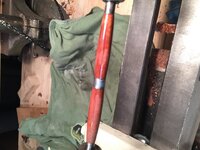For what it is worth, I went through the same process finding what worked for me with CA finishing. Sanded through a few finishes while trying to find the happy medium between "enough coats" and "too many coats". Here is my process;
When applying CA, I have the lathe on minimum speed (for me that is like 600 rpm, wish it would go slower, but this speed does not sling off the CA), I dribble it on the turning blank while smoothing back and forth with open-cell foam pads and very light touch (same material used in the foam paint brushes). This smooths out the CA very nicely and I get more consistent layers than I ever did with paper towels. The foam does tend to react with the thin CA though (hasn't been a factor with medium), so if you are doing a two-piece pen, switch pads between pen halves, or it will flash and bond to the second piece.
1. Sand to 600 or 1000 grit.
2. 2 coats thin CA. (haven't done the acetone on oily woods to date, but that sounds like great advice from the other posters).
3. 2 coats medium CA. These build up thickness nicely. Accelerator after 40 seconds of drying, then wait another 30 seconds before applying next coat. Otherwise you will get a surprise when that odd bit of accelerator welds your foam pad to the work-piece on the next coat.
4. 1 or 2 coats of thin CA. This will really fill in the roughness of the medium CA coats and reduce the amount of leveling required. Never apply accelerator to the very last coat. Let it dry at least a couple of minutes normally to keep from "fogging" up the finish with the accelerator.
5. Level with 400 grit wet sandpaper. Sand until the entire blank has the same dull sheen to show you have leveled all the high spots. Any glossy spots left are low spots and you need to keep going. With the process above, I have yet to sand all the way through the finish with 400 grit at this stage. Any rougher grit and I think the risk is too great.
6. Gently sand with 600 wet then 1000 wet.
7. Micromesh to 12,000. Since I sand to 1000 with sandpaper, I can usually skip the first 2 grits of micromesh. I found that quality wet/dry sandpaper seems to be a little more predictable on removing and leveling than the rougher micromesh pads, but I haven't done a side by side test with a magnifying glass to verify.
I do know my process needs to improve by adding a buffing system in place of the micro-mesh if I want truly glass clear finishes, but so far this has worked very well for me. Definitely get better polishing results if you let the CA finish cure overnight (after step 4 or 5) before leveling and polishing out.
Also, your mileage may vary depending on the CA glue you use. I found StickFast medium CA to be a touch too thick to flow out nicely for finishing, but the Satellite City medium CA seems to flow pretty well, at least until the bottle has been open a few months. The foam pads help for sure.

